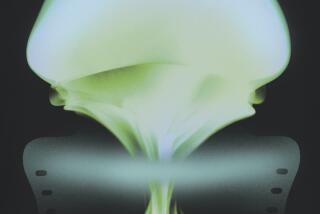MOVIE REVIEW : ‘Radio Bikini’: Documentary With Fallout
- Share via
In 1946, the United States, fresh from victory in the Pacific, staged two nuclear explosions near the remote Pacific island of Bikini. It was the first attempt at scientifically analyzing the effects of nuclear weaponry. The resonant fallout from the experiments form the basis of “Radio Bikini,” (Monica 4-Plex, Saturdays and Sundays through March 27) an extraordinarily perceptive, haunting and informative documentary.
The film by British film maker Robert Stone (an Oscar nominee for feature documentary) is an outstanding achievement on all levels. Stone conveys an enormous body of facts, figures, attitudes and effects in the most organically subtle fashion. There’s also a uniquely emotional quality thanks to the participation of two witnesses--Kilon Bauno, the chief of 162 Bikinians who were relocated throughout the Marshall Islands to clear the way for the nuclear invaders, and John Smitherman, a Navy pilot involved in dropping the bombs.
Operation Crossroads, the code name assigned the experiment, was anything but covert. About 42,000 servicemen and observers were on hand for the two July detonations that were filmed and broadcast throughout the world. It was a demonstration of American might and a huge media event to foster the idea of the U.S. as responsible and concerned guardians of this powerful new device.
Delving into historic archives, Stone has unearthed some sobering, formerly classified material that serves as the body of “Radio Bikini.” The U.S. government spared no expense to capture every possible second from every conceivable angle (apparently half the world’s supply of film stock was consigned for it) of what was to be the definitive propaganda film of the era. It was never made but footage wound up in the newsreels. Now, more than 40 years later, the fact that it is used for a purpose contrary to its intent might simply be regarded as justice.
In hindsight, Crossroads was the most chilling experiment of all time, even if the scientists and politicians of the postwar years believed it was conducted in a sane and safe fashion. Apparently there was a belief in 1946 that you could reason with radioactivity. But after the first detonation, the footage reveals government observers’ disappointment. The viewer will be awe-struck by images of a goat that survived the blast placed in sharp contrast to the expectations of officials who anticipated something apocalyptic.
The sentiment at home was overwhelmingly gung-ho for the operation, though the incident also attracted the first anti-nuke demonstrators (footage Stone also incorporates). One of their placards reads: “Wrong Road to Peace,” and it’s these jarring images and the inflection of “we leave this to the judgment of history” and other official words of rationalization that echo all the way to the present.
The misfire of Operation Crossroads is ultimately symbolized through personal tragedy. Bauno’s desire to return to his home remains unrealized (Bikini is still too radioactive to sustain human and plant life), and the physical and emotional scars inflicted upon Smitherman, as anyone can see, are truly shocking. Finally, “Radio Bikini” is an enviable artistic contradiction: It presents itself with quiet conviction but its underlying passion burns in our minds and souls.
More to Read
Only good movies
Get the Indie Focus newsletter, Mark Olsen's weekly guide to the world of cinema.
You may occasionally receive promotional content from the Los Angeles Times.










